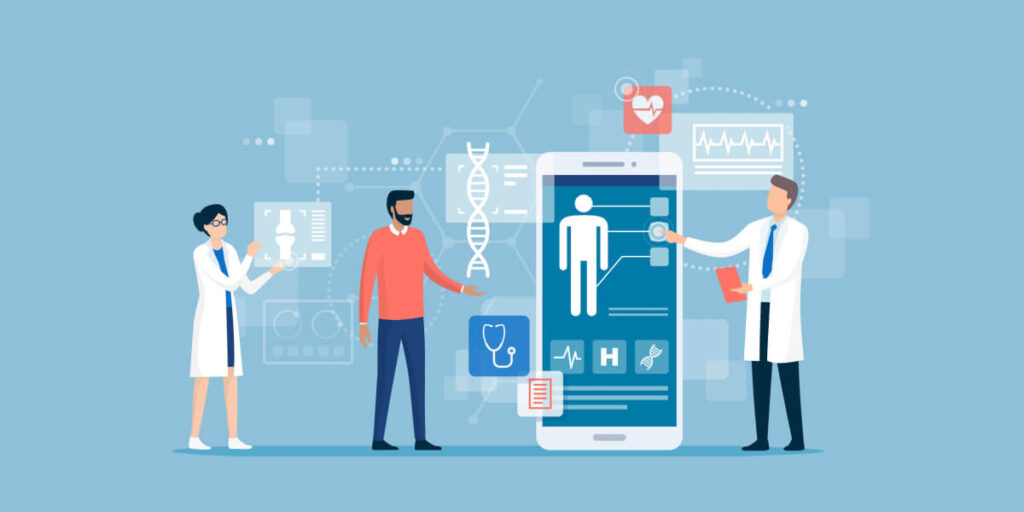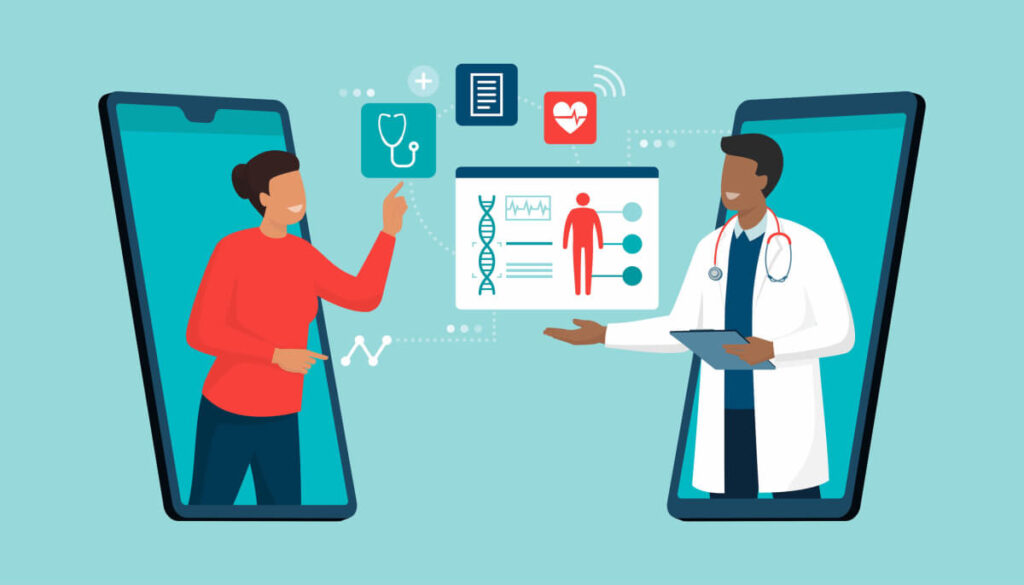Paper documents have carried the medical industry for centuries. However, it’s not without its flaws. A paper record can easily be misplaced or destroyed by elements like fire, water, or pests. Paper records that are filed away can take up too much physical space in a business, and, when it’s time to retrieve these records, the office staff will take a considerable amount of time to find the documents they need,when this time could be otherwise spent on other office duties.
So how are paper documents turned into electronic medical records? All patient charts are scanned by independent firms and then integrated to the EMR of the hospital. Below is a detailed explanation of how medical centers are going digital and entering paper documents into their patients’ electronic medical records.
To this day, paper-based records aren’t completely obsolete, and some healthcare facilities are still using a combination of paper-based and digital documentation. While some medical and healthcare facilities are still transitioning to a fully digitized system, many of these facilities still see the advantages of paper documents and use a combination of paper documents and EMRs.
Facilities that are transitioning or have fully transitioned to electronic health record data, there are many ways paper documents are entered into patients’ electronic records. Older paper documents are either scanned and filed as digital images in the medical organization’s cloud storage. When these document images are required by medical professionals, legal counsels, or any authorized users, a secure digital copy is provided.
For more recent paper documents, some medical and healthcare facilities can easily scan or encode paper documents into an electronic template that offers a more uniform process that can streamline documentation and patient data.
And then there are healthcare facilities that have fully transitioned to EMRs and have very minimal need for paper documents. If they do require paper documents, these are quickly scanned or encoded to their system to make data more accessible to those who need it.
By entering data from paper documents into a patient’s electronic health record, healthcare providers not only make it easier for their staff to access this information in the future if it’s needed but also helps the patient and other healthcare facilities that may need the patient’s information to help treat them.
EMRs connect the medical records of a patient in one health facility with the medical records of another facility with a compatible system. This allows facilities to consolidate a patient’s medical records, their medical history, and other important information into accurate records. These are then used by facilities to properly diagnose their patients and provide the right patient care. So, when one care provider takes in a patient, they can easily access compiled information that can help them understand a patient’s case.
Thanks to regulations under the Health Insurance Portability and Accountability Act of 1996 (HIPAA), all protected health records (whether on paper or digital) should only be shared on a need-to-know basis. Since 2014, EMRs are required to carry information that are “in meaningful use.” That’s why certain healthcare organizations that only focus on a certain service should not be holding medical information that isn't related to the services they provide.
In the past, securing medical information from unauthorized access meant a long and strict process before doctors and other medical professionals from different facilities could get access to a patient’s data. Not only was it time-consuming (which could compromise critically-ill patients in need of emergency patient care), but it was an expensive cost for hospitals, which translated to higher additional costs for the patient.
Today, various EMRs with compatible systems link hospitals, clinics, and other medical and healthcare records. And by digitizing paper documents, doctors and other healthcare professionals have more patient information that could help them treat their patients’ conditions more accurately.
One of the bigger hurdles in the medical industry is when healthcare providers have limited information to treat their patients. Many patients can orally communicate their medical history, sign medical directives, and have laboratory tests done, but not all who come into medical facilities may have the time or capability to do so.
A patient’s own personal health record is essential for doctors who want to give an accurate diagnosis and the safest treatment for it. By linking facilities like hospitals, clinics, laboratories, pharmacies, and other healthcare and medical organizations’ patient data, doctors and other professionals can get a bigger picture of the patient’s actual record.
Today, blockchain technology like electronic systems have allowed doctors and hospitals to consolidate a patient’s records into one accessible file. This can help doctors quickly determine how much medical care they require and the limits of treatments or medication.
Transferring medical records from paper to the cloud was a big step for the medical industry as it provided doctors with a patient’s entire medical history. Unfortunately, that’s not to say that EMRs are universal. Many healthcare facilities are either still transitioning to EMRs or have yet to go digital. It puts both their medical staff and their patients at a disadvantage because doctors can only go by the history their patients’ tell them, while patients do not get care from medical staff who have a clear idea of their patient’s medical record.

Not all hospitals, medical centers, and healthcare facilities carry the same format of electronic medical records. Depending on what’s necessary, some healthcare facilities may only carry the basics of medical records, while hospitals carry more comprehensive records. However, most organizations carry records of the following.
Of course, the basics of any medical record should contain the identification information of any patient or customer. However, most organizations will require more than just your name to accurately compile the rest of your medical records together. This can include your:
A patient or client’s medical history is a compilation of all the medical-related information on them. Think of histories of patients as painting a picture of a patient or client. A patient whose current record has minimal diagnoses and history is someone who’s likely in fit condition and has rarely needed medical care. On the other hand, someone with a long list of treatments and diagnoses suggest a patient that is more prone to chronic or acute ailments. This includes:
One of the benefits EMRs has provided healthcare providers is that doctors could look into previous medical and laboratory results rather than having their patients undergo the same test twice under two different facilities. This helped to reduce the patient’s costs while also streamlining the diagnosis by giving doctors more available medical information.
A patient’s history of medications can affect their health and the efficacy of medicines later in life. This includes over-the-counter medicines, prescriptions, herbal remedies, and even illegal substances.
This is crucial especially for doctors prescribing medicine since some medicines should not be taken with certain types of medicines at risk of worsening symptoms. And aside from medications, having access to information like patient allergies can help doctors avoid prescribing medication that can trigger allergic reactions.
A patient’s family history can be indicative of genetic risks that make them more prone to certain conditions or diseases.
For one example, a person can have the recessive gene for sickle cell anemia but not show any symptoms because they didn’t receive the gene from both their parents. While that person might be safe, their child may be at risk for sickle cell anemia if they have a child with someone who has the gene.
In another example, diseases like Type 2 Diabetes can be hereditary. However, even if both parents have Type 2 Diabetes, there’s no guarantee that their child will have it later in life. However, if their child practices an unhealthy lifestyle into adulthood, there’s a much higher chance they will develop it.
Treatment history is essential for doctors as it indicates which treatment patients have undergone in the past and whether or not it was effective. For example, a patient’s treatment history can include being given antibiotics to fight off bacterial infection. Knowing this can help doctors prevent overexposing their patient to antibiotics and causing antibiotic resistance.
Medical directives, on the other hand, are the instructions of a patient or their legal guardians about what to do in case of medical emergencies. For example, if a patient in critical care does not wish to be resuscitated in case of an emergency, it is much more efficient for them to have a DNR on record rather than signing multiple forms and waivers each time they receive medical attention.

Transitioning from paper records to electronic medical records is more than just having less paperwork to file manually. It can benefit both the hospital or healthcare facility and its patients through various means. To name a few a few of these benefits:
Medical records are protected by HIPAA. In the past, this meant that medical documents were heavily guarded to protect sensitive patient data. As a result, retrieving medical data was a time-consuming process that involved a lot of hurdles.
Today, with the HIPAA-compliant technology of various EMR software, gathering consolidated patient data becomes an efficient, secure, and fast process. Medical practitioners in need of patient information fast will not only find it easier to gather the clinical records of the patients, but would also relay information to and from medical professionals and patients.
There have been many instances where patients receive cookie-cutter or even wrong treatment because doctors didn’t understand the full extent of a patient’s condition. However, now that EMRs have made data easier to share, medical practitioners can get a better view of a patient’s medical condition and understand the best way to provide patient care according to their needs.
Earlier, we talked about how medical records in facilities can contain medical directives, including DNRs. Having medical staff ask patients to sign DNRs every time a patient seeks medical treatment is not only counterproductive but can also be impossible at times. For instance, if a patient enters a hospital unconscious or unable to communicate, medical staff cannot get consent from the patient themselves and will have to ask their next-of-kin who might not have the same wishes as the patient.
Doctors can also protect themselves from medical malpractice through EMRs. Patients must sign non-editable forms consenting to certain treatments or operations. These digital documents are time stamped and serve as proof of a patient’s consent and can prevent lawsuits of medical malpractice due to erroneous entries.
While paper documents have their advantages, electronic medical records are the way to go for those who want seamless data storage, improved health management for patients, and reliable information with just a few clicks. It streamlines medical protocols, provides easier secure access to authorized users, and benefits both patients and healthcare providers.
For the aesthetic and dermatological clinics in search of an electronic medical record software that fits with their business’s needs, Calysta provides the all-in-one EMR solution: HIPAA-compliant secure cloud storage, custom note templates, practice schedules, and more - all in one software.
Calysta’s electronic medical record software offers more than just an efficient way to manage your patient records. Schedule appointments, host online meetings, collect payments, and ensure the safety of your patients’ information. Try Calysta today.